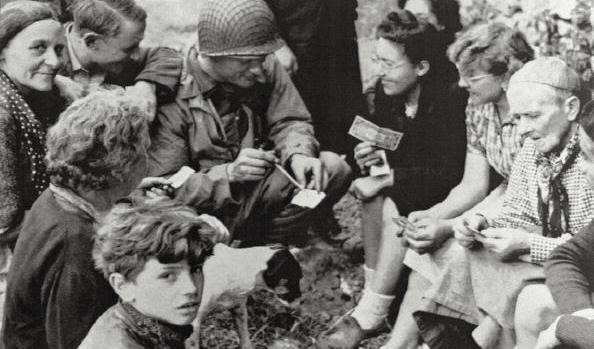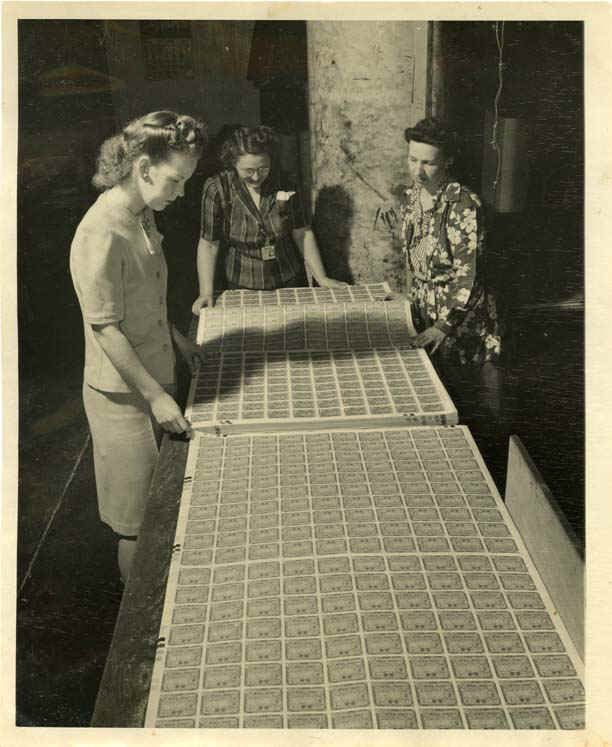Military currency and occupation money are money provided for the use of military personnel serving in occupied territory. Depending on circumstances, military currency can be provided by an aggressor or a liberator and take a variety of forms for use by military and / or local populations. In the case of Hawaii in World War II military currency was swapped for the US dollars on the island in preparation for a possible Japanese invasion. This pre-empted the possibility of Japan gaining control of all the US dollars in Hawaii since ‘greenbacks’ were internationally negotiable. -ie accepted in most countries and so potentially an economic windfall to Japan. Many countries including Japan, Germany, Austria, The United States of America, and Britain have produced military currency during conflicts between World War II and Vietnam. The equivalent to military currency now used by military personnel serving overseas is the value-added charge card.

Military Currencies
Military Currencies are issued strictly for the use of troops serving overseas; they are prepared by a (military) power or Government and declared by the overall commander to be legal tender for use by civilian and/or military personnel as prescribed in the areas occupied by its forces . ‘Military Currency’ should be of a distinctive design so as to be able to distinguish it from the national (i.e. official) currency of the country concerned, but it may be denominated in the monetary unit of either .
Men of “K” Section, Signal Section, Headquarters 5th Parachute Brigade, discussing Invasion Currency at RAF Fairford on the 3rd June 1944. Signalman John Easby (left) parachuted into Normandy on the 6th June and later participated in the Rhine Crossing on the 24th March 1945, where he was taken prisoner. Signalman Douglas Davis (centre) was killed on the 6th June when the glider in which he was travelling crashed near Saint Vaast en Auge. Also killed in this crash were both of the glider pilots, Staff-Sergeant Colin Hopgood and Sergeant Daniel Phillips, Captain Spencer Daisley and Private John Aldred (both 13th Parachute Battalion). Copyright: Imperial War Museum.
Historically, soldiers serving overseas had been paid in local currency rather than in their “home” currency; most cash drawn by soldiers would go directly into the local economy, and in a damaged economy the effects of a hard currency such as the dollar circulating freely alongside weaker local currencies could be severely problematic, risking severe inflation. There were other problems as well; once dollars were circulating in a combat region, the opposing side could freely use its own stocks of dollars as currency, or acquire stocks for use elsewhere. The high purchasing power of the dollar, and its easy transference back to the United States, also posed a significant incentive to black-marketeering.
However, whilst the use of local currencies was effective where they were provided in cooperation with the local authorities, it was impractical in combat zones where the government might be either hostile, deliberately ambivalent, or simply non-existent. In these cases, the military authorities issued special “military currency”, which was paid out to soldiers at a fixed rate of exchanged and simply declared legal tender in occupied areas by local commanders.
Navy Beachmaster Joseph P. Vaghi explains the worth of invasion money on 19 June 1944 to villagers of St. Laurent sur mer, Normandy, France. In the early publication of this famous AP photo, military censors removed “Navy Beachmaster” and used the words “navy observer.” – Nothing could be further from the truth!
Allied Military Currency was issued for use in Italy, France, Germany, Japan and for a short time in Korea, Denmark and Austria. Some of these currencies saw service in other parts of the world as well. As a general rule, the use of this currency was in response to local Black Market activity and the associated need to stabilize the local economy. They were issued for use by military personnel only and generally on base only. In some cases the civilian population would accept these notes for goods or service and discover that they could not exchange them for the local currency. Many soldiers brought these notes home as mementos and now seventy years later they are collectible as a part of military history.



Operation Husky (Italy)
The Am-Allied Military Currency or lira was the currency that AMGOT put in circulation in Italy after the landing in Sicily on the night between 9 and 10 July 1943. The value was 100 “am-pounds” for a U.S. dollar. Totally interchangeable with the normal Italian lira for military decision, it contributed to high inflation that hit Italy towards the end of World War II.
The study of paper money specific to Italy began in July 1942. The first issue (Series 1943) was printed by the Bureau of Engraving and Printing(BEP, who has also designed the banknotes) and the Forbes Lithograph Corporation (FLC); the value was written only in numeric digits and the Italian language. This was hurried rough. On July 13, 1943, on the banknotes were printed and written LIRA or LIRA ISSUED IN ITALY, previously omitted so as not to betray the country to which the notes were intended.
With the first series were issued of the denominations of 1 to 1000 pounds. The banknotes for 1, 2, 5 and 10 pounds are a square shape, and the 50, 100, 500 and 1000 pounds have a rectangular shape, same general shape as the U.S. dollar.
The second issue (Series 1943 A) was printed only by the FLC, and was added to the indication in letters (in Italian and English) of the value. Due to rampant inflation, they did not reissue the banknotes for 1 and 2 pounds, which had become useless. For printing, lithography was chosen as the method with “high specific spectral ink” and paper materials like rags. All this should have made it very difficult to counterfeit. In fact, the falsification of Am-lire was a very large phenomenon; some were crude counterfeits, while others were hardly distinguishable even by experts. The reverse of all the banknotes read in English the Four Freedoms enshrined in the United States Constitution: the freedom of speech, the freedom of religion, the freedom from want, and the freedom from fear. After 1946, they ceased to be the currency of employment and were used along with normal notes, until June 3, 1950. In total, 917.7 million Am-pounds were printed, a weight of 758 tons were shipped to Italy in 23,698 cases. The first shipment, seven tons of paper money, took place July 19, 1943, on two cargo planes, while the last delivery was made April 17, 1945.
Operation Tom Cat (France)
The “flag ticket” franc (French: Billet drapeau) was printed in the United States under strict security conditions by the Forbes Lithograph Manufacturing Company, Boston, Massachusetts and transported to Britain. For D-DAY, 19 trucks were required to deliver 3 billion French Francs, which were needed to change the British money held by American servicemen into French Military Currency and to cover a partial payment of US$ 4.03 per serviceman ! It should be noted that prior to D-Day, Allied servicemen also received, apart from the new ‘Invasion Currency’ current French banknotes, in circulation on the continent .
With the swift take-over of sovereignty by General Charles de Gaulle, who considered the US occupation franc as “counterfeit money”, the currency rapidly faded out of use in favour of the pre-war French franc.
There were two issues for use in allied controlled areas of occupation. The first issue is known as, “Supplemental” and has a french flag on the reverse. These notes were issued in denominations of 2, 5, 10, 50, 100, 500 and 1000 Francs.
The second issue, known as the “Provisional” issue replaced the first issue in June 1945. These notes have “France” printed on the reverse and were issued in denominations of 50, 100 and 1000 Francs. The 2, 5 and 10 Franc supplemental notes remained in circulation with the Provisionals until late 1946 and in the case of 50 and 100 Franc notes until 1948.



Operation Wild Dog (Germany)
There was one issue of this series printed by both the U.S. for allied use and the USSR for use on their side of the joint occupation of Germany. All notes are in denominations of 1/2, 1, 5, 10, 20, 50, 100 and 1000 Mark. These notes circulated through mid 1948. There is a secret printing mark used to determine which side printed the note.
Operation Toy Horse (Japan)
B Yen was a colloquial term used to refer to a form of military scrip used in post-war US-Occupied Okinawa from April 15, 1946 to September 1958. Officially, it was called B type military scrip.
The designation “B type yen” derives from the fact that, for a time after the US occupation of Okinawa Prefecture began, following the end of World War II, the US military used a separate scrip called “A type yen” while “B type yen” were only used by the local civilians. In the brief time between the 1945 battle of Okinawa and the beginning of the US occupation, the islands went from a currency-free system, relying upon barter and distributions of supplies from the authorities, to the reintroduction of currency with the B yen, the introduction of the new Japanese yen (both “new yen” and “B yen” being used concurrently for a time) and then the establishment of the B yen as the only legal currency.



Those notes with the “B” under print were used in Japan from late 1945 through 1948 and to 1958 in areas of occupation off shore. While most notes were printed by Strecher-Traung, some notes of 1, 5 and 1000 Yen were printed in Japan by the Finance Ministry. The BEP apparently only printed 1 Yen “B” under print notes.
British Authority Notes
These notes were originally issued in North Africa some time in early 1943. They were not very successful but none the less were used later in Sicily and apparently in Greece by British troops. Some may have been used in other countries with an overprint of some sort. Notes were issued in denominations of 6 pence, 1, 2/6, 5 and 10 shilling, and 1 pound.






Not Available in the Shop?
Custom Orders
If you want something that is not available in the webshop, or if you have original piece of paperwork that you would like to have reproduced, or you want some paper props made for your next movie production, please get in touch me. Then I can see if I can make it for you.


